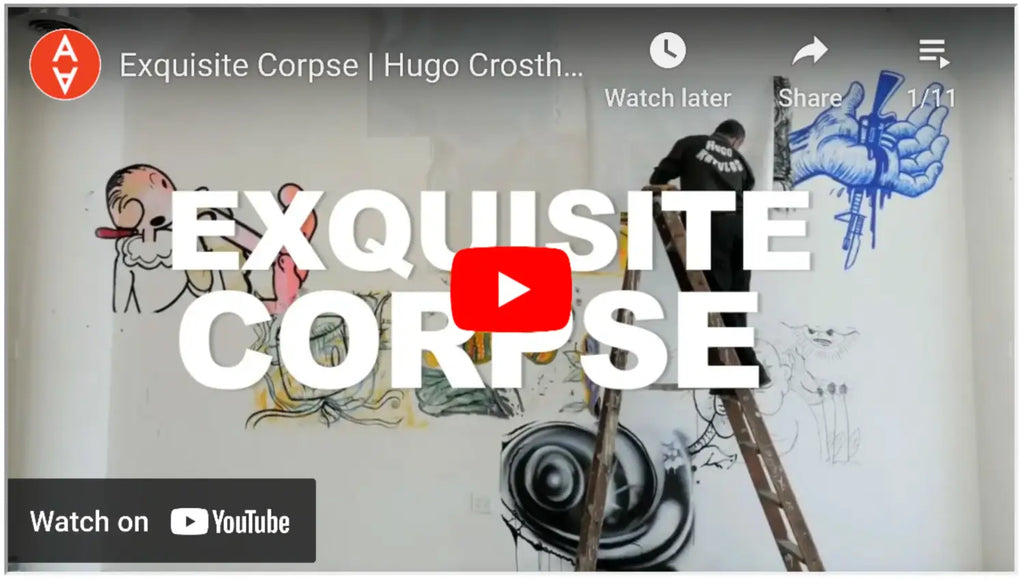Paris in the 1920s teemed with midnight discussions and clashing creative visions, as if the city itself had grown restless to birth a new kind of expression. In tight Montparnasse apartments perfumed by intellectual fervor, painters, poets, and provocateurs hunted for the raw matter of dreams—yearning to capture the unconscious as starkly as one might net a butterfly in a moonlit garden. Their quest was both rebellious and intimate, an effort to channel unfiltered thought and reshape notions of what art could be.
Into this electric swirl emerged a playful, entirely original approach: the Exquisite Corpse. Born from a love of the unexpected, it was more than a simple parlor trick. It became a gateway, opening onto the vivid terrain of the Surrealists’ deepest fascinations. Within every strange angle and absurd image, a new dimension took form—one where collaboration trumped individual genius, and the hidden corners of the mind could roam free.
Key Takeaways
- Collaboration stands at the heart of Exquisite Corpse, with multiple artists contributing to a single unified piece without seeing each other’s work.
- Origins trace back to 1925 in André Breton’s Montparnasse home, fueled by the Surrealists’ fascination with the subconscious and the irrational.
- Historical works by André Breton, Man Ray, and Max Ernst demonstrate the technique’s capacity for delightfully unpredictable and often bizarre results.
- Playful methods, from drawing to writing, unite friends in a game that demands a willingness to surrender creative control and embrace the unexpected.
- Modern echoes, including digital and social media platforms, prove the Exquisite Corpse approach is timeless, weaving new visions of dreamlike possibility for curious minds everywhere.
A Game That Fueled a Movement
Exquisite Corpse—or Cadavre Exquis—did not arrive from nowhere. It sprang from a centuries-old parlor pastime called “consequences,” where participants added phrases or images in turns, folding the paper so nobody saw what came before. Yet in 1925, at the Montparnasse residence of André Breton, the Surrealists seized upon this playful old notion and electrified it with their radical vision.
In those gatherings, luminaries like Marcel Duchamp, Jacques Prévert, Yves Tanguy, and Benjamin Péret would crowd around a single page. Each artist contributed a fragment—an image, a word, or perhaps just a serpentine line—only glimpsing the narrow edge of what the previous participant offered. The resulting artwork resembled a fever dream: mismatched creatures, sprawling landscapes, words twisting into poetic riddles.
Breton championed this game as a means to bypass the conscious mind. He believed that in the gaps between what each collaborator saw and contributed, the purest sparks of creativity could ignite—free from rules, schools, and centuries of tradition.
The Magnetic Pull of the Unconscious
By the late 1920s and 1930s, Exquisite Corpse had become a rite of passage for Surrealists determined to tap the irrational. They reasoned that if society’s polished norms sprang from well-worn habits of thought, then true originality might only appear by tossing those habits aside.
Sometimes, they created drawings or paintings; other times, they improvised poems or strange narratives. Imagery bled into verse as if words and pictures emerged from the same dream wellspring. The point was simple but transformative: let chance disrupt intention, let the wild subconscious roam, and watch what appears.
Such juxtapositions—part playful lark, part artistic manifesto—captured everything the Surrealists adored. Absurdity, mystery, and the raw jolt of discovering something no single mind could produce alone.
Notable Moments in Exquisite Corpse History
“Le cadavre exquis boira le vin nouveau”—“The exquisite corpse shall drink the new wine”—this was the first Surrealist phrase born from the game. It lent the technique its permanent name, a nod to the idea that something eerily alive emerged when multiple minds collided.
André Breton orchestrated a celebrated event in 1938, summoning artists to craft a vision of a woman by dividing her body into four segments. Each part was rendered by a different hand, resulting in the now-famed drawing titled “Cadavre Exquis.” The final figure was simultaneously erotic, fragmented, and enchantingly bizarre—a puzzle conjured by creative cross-pollination.
Iconic Works Forged Through Collective Chaos
Beyond the 1938 “Cadavre Exquis” championed by Breton, other creations stand out:
-
“The Exquisite Corpse Shall Drink the New Wine” by Man Ray (1927)
Man Ray, always eager to test the boundaries of photography, folded and manipulated a single sheet of photographic paper. The result is a sequence of four distorted, overlapping faces—like ghosts stepping across each other in layers of silver emulsion. -
“Exquisite Corpse” by Max Ernst (1926)
In Ernst’s painting, alien life forms morph from bits of collaged imagery, swirling in a hazy, otherworldly vista. Some shapes might be half insect, others more like shards of a half-remembered dream. Perspective and composition are upended on purpose, reflecting the Surrealists’ desire to let chance run wild.
These examples prove that out of a single unseen junction, entire worlds can arise. The Surrealists took the creative process itself and snapped it into a puzzle, upending any sense of tidy completion.
An Invitation to Make Your Own Surreal Worlds
While the technique’s past is woven into the tapestry of art history, playing Exquisite Corpse is still as thrilling as it was in Breton’s living room. All you need is a group of adventurers willing to step outside their comfort zones:
- Gather friends who share a taste for the unconventional.
- Select your medium—maybe you draw, paint, or compose a short narrative.
- Agree on a theme or subject, whether it be a fantastical creature or a poem about lost horizons.
- Decide on the sequence of turns. Who goes first, second, and so on?
- Each participant starts an image or sentence, folding the paper so that only the bare edge of their contribution remains visible.
- Pass it along to the next person, who adds their own twist without fully knowing what came before.
- Continue until the final reveal astonishes and entertains everyone present.
It’s critical to embrace the spirit of unpredictability. No single hand controls the final outcome. Allow each whimsical addition to flourish, even if it seems outlandish or mismatched. That clash of styles is exactly what makes the Exquisite Corpse unforgettable.
Exquisite Corpse in the Digital Age
Curiously, this method did not fade with the last generation of Surrealists. If you venture onto YouTube or other digital platforms, you’ll find numerous Exquisite Corpse projects. Painters, writers, and filmmakers from Tokyo to Toronto post segments of a collaborative story, then pass it on to strangers around the globe, letting each participant’s contribution become part of a growing virtual mosaic.
Even social media spaces can morph into experimental Exquisite Corpse labs, with collaborative tweet threads or image-based challenges. In these new realms, the same principle applies: each person sees just enough to spark curiosity, then plunges into creation without a clue about the bigger picture.
The Ongoing Spell of Collective Imagination
Unpredictable and irresistible, Exquisite Corpse holds a mirror to how art—and life—can flourish when we trust what lies beyond our conscious control. André Breton and his circle might have gathered in cramped Parisian flats almost a century ago, but the spirit they unleashed still flickers in countless corners of modern culture.
When you assemble a handful of creators, fold a sheet of paper, and surrender any notion of single authorship, something strangely vibrant often appears. The game’s legacy endures precisely because it invites an endless capacity for surprise. In a world that prizes the polished, the curated, and the carefully planned, the Exquisite Corpse remains a tonic—a reminder that the most startling beauty might emerge from the unexpected union of many voices.
This singular technique, so humble in its approach yet so infinite in its possibilities, challenges us to leave safe territory. The reward is a glimpse of the impossible made real, a reminder that when the conscious mind steps aside, creativity roars into bloom. Such is the abiding thrill of the Exquisite Corpse, a surreal testament to the boundless imagination that waits to be set free.















